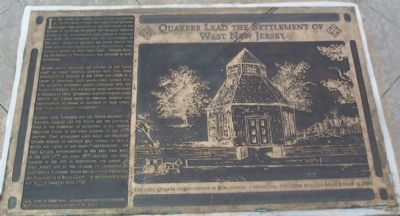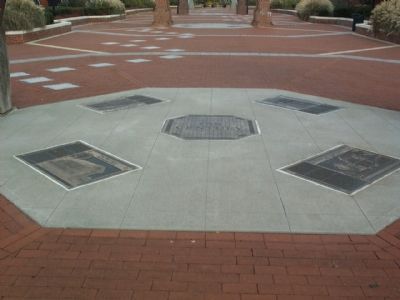South Trenton in Mercer County, New Jersey — The American Northeast (Mid-Atlantic)
Quakers Lead the Settlement of West Jersey
Quaker beliefs, based on the concept of the “inner light” or direct spiritual contact with God, were formulated in England in the 1650s and 1660s by a group of preachers, chief among them George Fox. The religious movement rapidly coalesced into the Society of Friends, but was banned from group worship in England in 1662. Quakerism does not employ a paid ministry, but rather relies on personal example and self-discipline to spread its doctrine of plain living, hard work and peaceful co-existence.
Quakers from Yorkshire and the North Midlands of England, families like the Stacys and the Lamberts, were at the forefront of settlement in the Middle Delaware valley in the final quarter of the 17th century. They established large farms and practiced Quaker worship at meetings held initially in private homes and, later, at the nearest meetinghouse. The first Quaker meetinghouses in the area were built in the late 17th and early 18th centuries and were located in the city of Burlington, the capital of West Jersey, and in the villages of Crosswicks in Chesterfield Township, Stony Brook outside Princeton and Fallsington in Bucks County. A meetinghouse was not built in Trenton until 1739.
Links to learn more – Quaker Meetinghouses in Trenton, Fallsington and elsewhere in the region
Erected 2004 by New Jersey Department of Transportation.
Topics and series. This historical marker is listed in these topic lists: Churches & Religion • Colonial Era • Settlements & Settlers. In addition, it is included in the Quakerism series list. A significant historical year for this entry is 1662.
Location. 40° 11.887′ N, 74° 45.498′ W. Marker is in Trenton, New Jersey, in Mercer County. It is in South Trenton. Marker can be reached from New Jersey Route 29. This marker is part of South River Walk Park which is built over Route 29. Touch for map. Marker is in this post office area: Trenton NJ 08611, United States of America. Touch for directions.
Other nearby markers. At least 8 other markers are within walking distance of this marker. Europeans at the Falls of the Delaware (here, next to this marker); The West Jersey Proprietors Rule (here, next to this marker); William Trent of Trent’s Town (here, next to this marker); Native Americans in the Archaic Period (here, next to this marker); Native American Artifacts – Clues to Prehistory (here, next to this marker); c. 3,000 – 10,000 Years Ago (here, next to this marker); What happened to the Lenape? (here, next to this marker); Native Americans Exchange Furs for European Goods (here, next to this marker). Touch for a list and map of all markers in Trenton.
More about this marker. This is one of 4 subject markers under the 17th Century Arch.
Credits. This page was last revised on February 16, 2023. It was originally submitted on December 16, 2007, by Gary Nigh of Trenton, New Jersey. This page has been viewed 1,852 times since then and 119 times this year. Last updated on February 2, 2021, by Carl Gordon Moore Jr. of North East, Maryland. Photos: 1, 2. submitted on December 16, 2007, by Gary Nigh of Trenton, New Jersey. • Bill Pfingsten was the editor who published this page.

